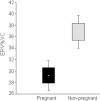Causes of respiratory ailments in pregnancy
- PMID: 21147649
- PMCID: PMC4360301
- DOI: 10.1186/2047-783x-15-s2-189
Causes of respiratory ailments in pregnancy
Abstract
Objective: During pregnancy, especially during its third trimester, most pregnant women reported respiratory discomfort (dyspnea), despite the absence of previously coexisting respiratory illnesses. The aim of this study was to determine the reason for this discomfort.
Material and methods: The study included 24 women examined before and after childbirth. Evaluation of respiratory complains was made on the basis of the respiratory questionnaire of St. George's Hospital. The data were correlated with the results of static and dynamic spirometric tests performed before and after childbirth.
Results: Pregnancy did not affect vital capacity (VC). Frequency of perceived symptoms correlated positively with IRV and the ratio IC/VC. A negative correlation was found between ERV and its derivative ERV/VC. There was no relationship between perceived discomfort and parameters of the flow-volume loop.
Conclusions: The extent of perceived respiratory discomfort (dyspnea) during pregnancy was primarily associated with a reduction in expiratory reserve (ERV).
Figures






References
-
- Juniper EF, Daniel EE, Roberts RS, Kline PA, Hargreave FE, Newhouse MT. Improvement in airway responsiveness and asthma severity during pregnancy. A prospective study. Am Rev Respir Dis. 1989;140:924–31. - PubMed
-
- Schatz M, Dombrowski MP, Wise R, Momirova V, Landon M, Mabie W, Newman RB, Rouse DJ, Lindheimer M, Miodovnik M, Caritis SN, Leveno KJ, Meis P, Wapner RJ, Paul RH, O'Sullivan MJ, Varner MW, Thurnau GR, Conway DL. Spirometry is related to perinatal outcomes in pregnant women with asthma. Am J Obstet Gynecol. 2006;194:120–6. doi: 10.1016/j.ajog.2005.06.028. - DOI - PubMed
MeSH terms
LinkOut - more resources
Full Text Sources
Medical
